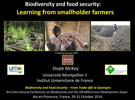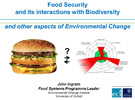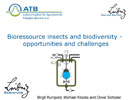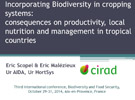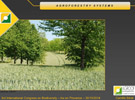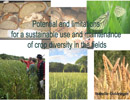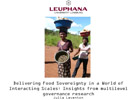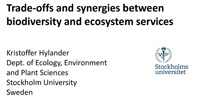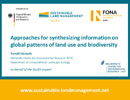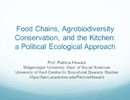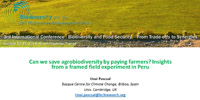
|
|
|
Programme > Keynote presentationsOct 29, 16:00: Opening SessionOct 30, 9:00: Session 1 - Environmental changes and food security: consequences and opportunitiesBiodiversity and food security: learning from smallholder farmers In the search for new pathways toward ecologically and socially sustainable agriculture, the ‘traditional’ agricultural systems conducted by smallholder farmers in many regions are a rich source of ideas for ways to reconcile food production, ecosystem services and the conservation of biodiversity in a changing world. Increasing research has uncovered a wealth of knowledge about these systems, but awareness of this knowledge, and thus its potential influence on policy, have lagged behind. This talk will focus on three themes. First, I will show how smallholder farmers create and maintain diversity in their crop plants and use this diversity to combat biotic and climatic risks. Secondly, drawing largely on recent work done by the CESAB-funded project NetSeed, I will show how farming communities diffuse biodiversity in social networks of seed exchange and how these networks help make agriculture resilient to many challenges, including natural and human-made disasters and climate change. Thirdly, I will illustrate novel ways by which smallholder farmers imitate nature in their design of agroecosystems. Download presentation
Climate change, land degradation and food security in the Sahel – the relevance of migration as adaptive strategy Impacts of climate and environmental change on the livelihoods and mobility of the population in the West African Sahel have gained increasing academic and public interest in recent years. It is estimated that countries in the Sahel could lose over 30-50 percent of their agricultural capacity in the next decades. Since the majority of the population living in the West African Sahel depends on subsistence and small-scale farming, environmental changes such increasing temperatures and rainfall variability pose considerable risks to their livelihoods and food security. Migration can then constitute an important strategy to cope with changing conditions of the ecosystems. However, causes and motives for migration (as well as the decision not to migrate) overlap, and cannot be strictly divided into ‘ecological’ or ‘social’ categories. High mobility is characteristic for West Africa and deeply rooted in culture and history. Seasonal migration, for example, has been a long-lasting and continuing migration pattern for the diversification of livelihoods. Download presentation
Food and Nutrition Security and its interactions with Biodiversity and other aspects of Environmental Change This presentation considers the two-way interactions between human activities related to food and nutrition security (FNS) (in the context of the ‘food system’), and environmental change (in the context of ‘planetary boundaries’) noting especially the impacts on biodiversity. Download presentation Oct 30, 11:00: Session 2 - Green economy, food security, and biodiversity
Bioresource insects and biodiversity - opportunities and challenges. Due to the growing world population there is an increasing demand in alternative protein sources whereas the available land for the production of plant and animal protein decreases owing to desertification and urbanization. Furthermore, the rapidly decreasing resources of fossil fuels necessitate a more sustainable land use. This includes the establishment of novel utilization pathways of hitherto not or not optimally used biomass. Here insects offer prospective alternatives. They are a vastly underutilized bioresource and can be utilized for the bioconversion and valorization also of hitherto not usable organic residues to food, feed, chemicals, enzymes, bioactive substances, and energy. In comparison to conventional livestock, insects have higher feed conversion efficiencies, lower water and land requirements, and lower greenhouse gas emissions. Download presentation
Land sparing vs land sharing: where do we stand? Considering that the expected demand for food worldwide will double by 2050 (Tilman et al, 2002; Balmford et al 2005), what would be the best strategy for the development of agricultural production, taking into account biodiversity conservation issues? Waggoner (1996) was the first to use the term "land sparing" for nature conservation in agricultural production. More recently, Green et al. (2005) compared the level of biodiversity resulting from different modes of agriculture: conventional "land sparing" and green "land sharing". In the first model, agricultural areas are used intensively and have a high crop yield from a small plot of land, thus allowing more space for the permanent preservation areas, such as reserves of environment. In the second case, agricultural production would tend to be lower per unit area and a larger area of land is generally required to obtain the same crop yields than conventional farming, leaving less land for permanent conservation, but a higher level of biodiversity in the production area. When biodiversity is a linear function of yield, the two methods of agriculture lead to the same level of biodiversity for a given production target. If the relation between yield and biodiversity is convex – decreasing intensity of agricultural production improves biodiversity at deceasing rate - extensive farming leads to a biodiversity loss compared with intensive farming. The opposite result is obtained if the relation between biodiversity and yield is concave. According to Green et al., available empirical data from a range of cases in developing countries support a land sparing strategy. The main differences between land sparing and land sharing can be summarized by three points: (1) in land sparing, there is a stronger contrast between the land for agriculture and land for biodiversity than in land sharing, (2) in land sparing, agricultural lands are essentially homogeneous, while it is generally much more heterogeneous in agriculture land sharing, and (3) the variability of land cover and its value for biodiversity are at a finer spatial scale in land sharing than in land sparing. The scientific literature remains nevertheless heterogeneous in this domain and emphasizes various aspects of this issue related to productivity, topography, location, biodiversity structure and response, economic incentives, and prevailing development paradigms. Other considerations relate to farmers’ attitudes toward risk, social preferences toward biodiversity, food, or landscapes… Recent work stresses the potential role of markets (Desquilbet et al., 2013). The mechanism underlying the most interesting effect is the fact that the lower agricultural productivity associated with land sharing might result in higher prices that would impact negatively the demand for agricultural productions. The authors note that the larger part of the expected increasing demand for crop is related to animal feed which is explained by the growth in the human consumption of meat. In addition, the lower productivity of the "land sharing" model also has consequences to require more human labor, and therefore more agricultural employment. And it is widely admitted that a large part of the food insecurity is associated with low incomes, especially in rural areas. The “land sparing” vs “land sharing” debate is still widely open. Beyond the evidence that appropriate answers will remain geographically differentiated, a better understanding of the issues relates to the improvement of agronomic knowledge on the contents of the land sharing model. Download presentation
Incorporating Bio-diversity in cropping systems: consequences on productivity, local nutrition and management in tropical countries The science of agroecology, which is defined as the application of ecological concepts and principles to the design and management of sustainable agroecosystems has known these last years a tremendous renewal of interest among the community of agricultural scientists but also amongst policy makers. This is mainly due to the important ecological disservices and often failure to ensure food security provided by intensive modern agriculture and associated techniques based on the combined use of agrochemicals and high-yielding varieties in monocropped systems. The main principle of agroecology consists in assembling and increasing functional biodiversity in agroecosystems to enhance synergisms in order to provide various categories of ecological services such as the activation of soil biology, the recycling of nutrients, and the enhancement of beneficial arthropods and antagonists. Functional diversity may be enhanced through different practices and strategies which include crop rotations, cover crops, intercropping, crop/livestock mixtures, agroforestry mixtures, etc. One of the main challenges is to improve through ecological services the agroecosystem efficiency and to maintain crops productivity. There are several examples of success in stabilizing food production this way and besides, vegetal diversity may contribute to a more diversified alimentation impacting in health of rural communities. New strategies incorporating ecological knowledge gained from the observation of natural ecosystems and or traditional agroecosystems may be a credible alternative to design such innovative systems. Designing such novel agricultural systems calls for in-depth knowledge of biological regulations in ecosystems, but also for the integration of traditional agricultural knowledge held by local farmers. Integration of these two aspects is one of the challenges that agricultural science has to deal with today. In addition, although practices are applied at the plot and / or farm scale by farmers, their efficiency and associated services are expressed mainly at the landscape scale. This paper reviews some initiatives that lie behind these trends, analyzes the basic concepts underlying the design of such systems and their efficiency. It suggests new frameworks for action that include Nature observation, experimental and model-based designs and participatory approaches. Download presentation
Oct 30, 14:00: Session 3 - Sustainable use of biodiversityAgroforestry systems: How to approach the potentialities and complexity of such integrated agricultural production systems. Over the last decades, traditional mixed production systems involving crops, animals and trees were discouraged, facing the paradigm of productivity helped by technological innovations and petrochemical sector development. This model has led to a limited resilience to economic and climate changes, to environmental pollution, and to the alteration of the characteristics of landscapes. Facing these issues, the agriculture tends to evolved towards an agroecology model where land use practices have to ally sociological, economics and environmental benefits. Agroforestry is part of this new agroecological paradigm and tends to develop in industrialized countries. The aim of my presentation will be to provide elements of reflection on how agroforestry helps to build resilience into landscapes and how it contributes to insure food security. (i) The first part will be dedicated to give a quick overview of the diversity of temperate and mediterranean agroforestry systems from traditional to modern ones, and the main elements to approach their complexity. What inventory can we make of agroforestry systems in France? How does the introduction of trees modify the structure and functioning of the agroecosystem and how this contributes to the diversification of ecosystemic services? (ii) Then, facing territorial issues such as water quality, erosion…etc. we will approach what are the potentials of agroforestry systems in landscape scale using the examples of territorial projects Agroof is working on. (iii) Finally the talk will be concluded by a reflection on the complexity of R&D research and the interest of participatory approach in the understanding and developing of such systems. This conclusion will be illustrated be some of our initiatives. Download presentation
Biodiversity and Food Security - linkages in South-East Asian rice landscapes In order to advance long-term sustainable development of intensive land use systems, against risks arising from multiple aspects of global change, quantifications of the dependence of ecosystem functions (ESF) and the services (ESS) they generate are needed. Thus, within the BMBF-funded research project LEGATO research focusses on local as well as regional land use intensity (including the socio-cultural and economic background) and biodiversity, and the potential impacts of global change. LEGATO stands for: “Land-use intensity and Ecological EnGineering – Assessment Tools for risks and Opportunities in irrigated rice based production systems.” LEGATO deal with selected characteristic elements of the 3 service strands defined by the Millennium Ecosystem Assessment (MEA): a) Provisioning: nutrient cycling & crop production; b) Regulating: biocontrol & pollination; c) Cultural Services: cultural identity & aesthetics. Research is conducted in The Philippines and in Vietnam, in landscapes along a gradient reflecting changing geo-climatic and land use intensity, as well as cultural conditions. The focus is on landscapes shaped by irrigated rice. In particular we investigate the interactions between the rice crops and the surrounding landscapes in the light of ecological engineering (as an emerging discipline, concerned with design, monitoring, and construction of ecosystems). The overall objective is the elaboration and testing of generally applicable principles within the frame of ecological engineering. In the present contribution focus will be on the direct linkages of biodiversity and rice production and how to disseminate resulting insights for practical implementation. Download presentation
Tree agrodiversity, local knowledge and food systems across landscapes and through time in the Mediterranean region: examples from the Rif, northern Morocco. Mediterranean agroecological landscapes have been characterized since the domestication of crops by agrosylvopastoral activities and the shaping of extensive agroecosystems combining trees, cereals and pulses cultivation as well as pastoral activities that were fully integrated and linked to a great variety of diets throughout the region. Many of these such as the holm-oak truffle domestic forests, the chestnut agroecosystem, the cork-oak Montades (Portugal) or the mixed olive/ almond/ figs and cereal orchards in Maghreb, are fully recognized for their importance in hosting high levels of biodiversity. In my presentation, I shall present the socio-political and evolutionary contexts of three trees that structure traditional agroecosystems in the Rif in Northern Morocco, known as a hotspot for biodiversity in the Mediterranean region. These are: Olive (Olea europaea), the Mediterranean fig (Ficus carica) and almonds (Prunus dulcis). My aim is to show biocultural factors that shape tree agrodiversity over time and throughout landscapes and the intricate linkages with food systems. I shall give a general picture of the state of the art regarding the domestication of these three species at the Mediterranean level and their evolution in the westernmost part of the region in northern Morocco. I shall then discuss the types of agroecosystems where these trees fit into stressing upon sociopolitical contexts, including relationships with different exogenous projects over time that have shaped varietal agrodiversity. Finally I shall discuss the importance of these three species in food systems and how local knowledge attached to management of these species including reproduction techniques as well as post-harvesting (conservation and transformation) contribute to define diversity, quality for home consumption as well as commercial products for sale.
Oct 30, 16:00: Session 4 - Conceptual pitfalls in the food-biodiversity nexusThe ecological economics perspective is not a simple juxtaposition of economic ans ecological elements. Whereas the reform of the Common Agricultural Policy is still not satisfying for ecologists, the socio-economic aspects, such as the food security, the agricultural incomes or the employment, remain the major criteria for public decision makers. This observation highlights two topics :
Potential and limitations for a sustainable use and maintenance of crop diversity in the fields. Over the past 50 years, homogenization has been the dominant agricultural paradigm of industrialized countries, involving genetically homogeneous crops in the fields with intensive use of inputs and replacing human labor by fossil fuels. To reduce the environmental and social impact of these practices, while regulating the agricultural production despite the greater environmental stochasticity induced by global change, a different model of agriculture is required. This new model is now emerging, in which biodiversity and the mechanisms underlying its dynamics are considered as assets for a sustainable agriculture that would rely on a better use of ecological functions in agroecosystems. Crop genetic diversity should play a vital role in this model, as a key element contributing to the adaptability and resilience of the agroecosystems confronted to stresses and changing environments. However, the redeployment of genetic diversity within agroecosystems faces conceptual, organizational and regulatory challenges that could be solved if the new dynamics received more scientific attention and if new collaborative approaches between scientists and stakeholders were developed. Download presentation
Models that are simple, elegant and wrong: conceptual framing of the biodiversity food security nexus. The nexus between biodiversity and food security requires meaningful frameworks for managing systems to achieve the different goals associated with managing these two phenomena - namely ensuring human well-being and biological conservation. Such normative, 'integrating conceptual frameworks' add another layer of complexity to what are already multi-dimensional and contested Download presentation
Delivering food sovereignty in a world of interacting scales: Insights from governance research.
Julia Leventon; Leuphana University of Lüneburg, Germany
If food sovereignty is to be a path to food security, it must be understood within the broader political economy of the global food system. The food sovereignty movement recognises that global trade policies disempower ‘peasant' farmers, leading to poverty traps, unsustainable agricultural practices and food insecurity. Proponents of food sovereignty argue that changing such policies, and facilitating bottom-up, agro-ecological approaches to food production can improve food security and address a range of environmental challenges, including climate change adaptation and biodiversity conservation. However, all of these challenges play out over scales that extend beyond the local, and are addressed by an increasingly global governance system (for example, the UNCBD). I therefore argue that by isolating and privileging the ‘local' in food sovereignty, we create two key pitfalls:
Download presentation
Trade-offs and synergies between biodiversity and ecosystem services It is becoming increasingly clear that human well-being including food production depend on services provided by managed and unmanaged species and ecosystems. Two conceptual pitfalls that might cause misunderstandings and potentially misguide future research if not considered are:
Oct 31, 14:00: Session 5 - Science-based opportunities to reconcile food security, biodiversity conservation and sustainable developmentApproaches for synthesizing information on global patterns of land use and biodiversity. Changing patterns and intensity of land use exert pressure on ecosystems and biodiversity globally. As the demand for food and other commodities continues to grow, understanding the relationship between land use and biodiversity is of prime importance. This presentation will discuss several examples from the GLUES project (Global Assessment of Land Use Dynamics and Ecosystem Services) to show possible approaches for synthesizing global data on land-use intensity and biodiversity. One approach to study the drivers and impacts of agricultural intensification is the identification of archetypical patterns of global land systems. A new representation of land systems was recently developed by synthesizing a range of spatial datasets on land-use intensity, environmental conditions and socioeconomic factors. Mapping these archetypes reveals generic patterns of major land pressures across the globe but also shows the need for regionalized solutions to sustainable land management. Looking further into the implications of land use, global data can help examine how and where agricultural land-use intensity threatens biodiversity. This can be done by quantifying the spatial association among an array of agricultural intensity metrics and endemism richness. The analysis shows that regions where high land-use intensity and high biodiversity coincide are located in the tropics, but often not within currently recognized biodiversity hotspots. On the other hand, many areas of currently low land-use intensity occur in highly biodiverse regions, where threats from intensification may emerge in the near future. These findings are supported by a meta-analysis of almost 400 studies that examined the relationship between the type of land use and plant diversity. It is apparent that the complex effects of land use can lead both to decreases and increases in species richness and that additional factors associated with land-use types (e.g. edge effect, habitat age) are important. However, the strong geographical bias in conducted studies highlights the need for a globally representative sample of local land-use observations. These examples illustrate how different science-based approaches can help synthesize information needed to identify sustainable development paths for interrelated socio-ecological systems. Download presentation
Conservation in the kitchen: domesticity and agrobiodiversity management. The origin of the term ‘domestication’ is not arbitrary. Agrobiodiversity has been intimately linked with the domestic realm throughout human history, and this link remains just as strong today. Yet the kitchen is the most under-valued site of agrobiodiversity conservation: researchers and conservationists generally overlook women, culinary traditions, post-harvest processes, homegardens, and the domestic realm more generally. Yet most crop varieties are maintained to satisfy local food preferences and fulfill requirements of local food chains. When traditional culinary habits change or when food processing, preparation and storage knowledge is lost or becomes unusable, this can lead to a sharp decline in agrobiodiversity. Empirical evidence is reviewed showing that women, in their roles as housewives performing domestic tasks, sustain an intimate and important relationship with agrobiodiversity management and conservation. Culinary preferences, as well as the post-harvest processes that are required to provide edible and culturally acceptable food, have a marked influence on knowledge, selection, use, and conservation of agrobiodiversity. The knowledge and skills required in the post-harvest food chain are complex and dynamic, and studies show that women’s domestic knowledge about physical and chemical properties of plants in food processing and storage often correlates with formal scientific knowledge. Food storage and preservation skills that depend upon ethnobotanical and Traditional Environmental Knowledge (TEK) are vital to ensuring household food security and to ensuring that plants are useful to people and therefore subject to management and conservation. Some reasons for continuity of traditions and change in traditional food consumption and chains are therefore addressed. Download presentation Can we save agrobiodiversity by paying farmers? Insights from a field experiment in the Andes. Agricultural biodiversity is a key public good asset for food security and for adaptation to climate change. Continuing efforts are being paid to conserve germplasm in ex-situ facilities, but on-farm conservation of traditional crop varieties is equally important given the co-evolutionary characteristics of plant genetic diversity. Given rampant market and policy failures, on farm biodiversity is continuously being lost around the world. This paper treats this problem as a social dilemma and as a collective action one and addresses the differential impacts on decisions towards collective conservation of agrobiodiversity in the context of payments for ecosystem services (PES). A field game experiment is conducted with Andean farmers in the Peruvian Andes, around the lake Titikaka, framed around their decisions to conserve quinoa landraces. Results indicate that PES can be effective in motivating collective action, although individual rewards are likely to be superior to collective ones when the level of trust among farmers is low. We also find that collective rewards may have a stronger positive impact in contexts where communication and deliberation about collective action is robust. We also suggests that we ought to pay due attention to the potential indirect impacts of PES-like instruments on social preferences for agrobiodiversity conservation, including intrinsic motivations. Download presentation
Oct 31, 15:30: Closing Session |
